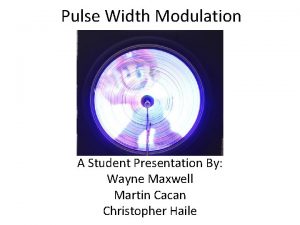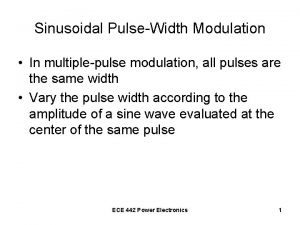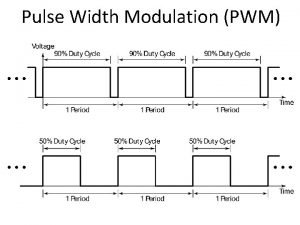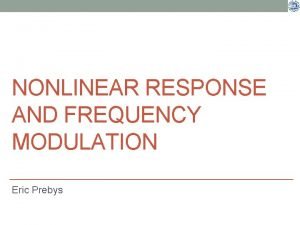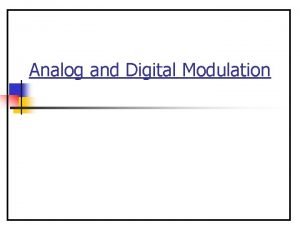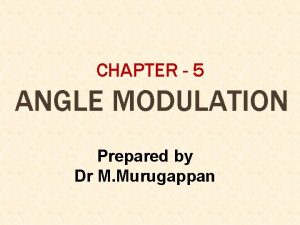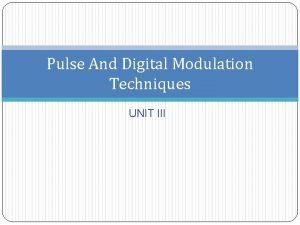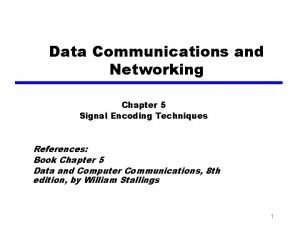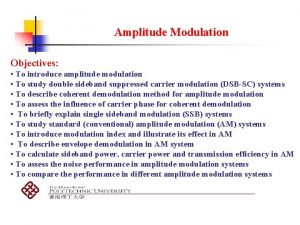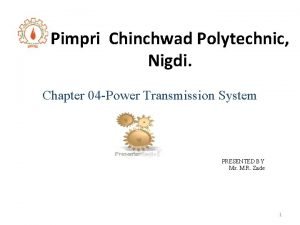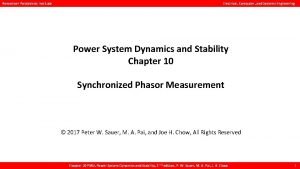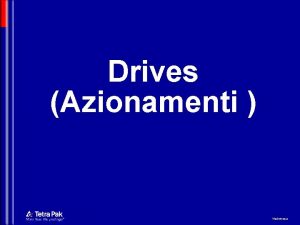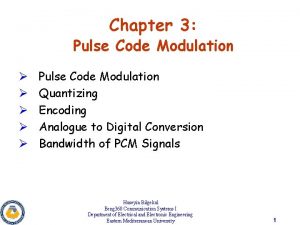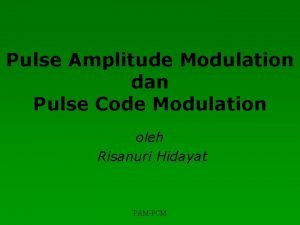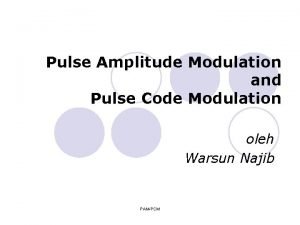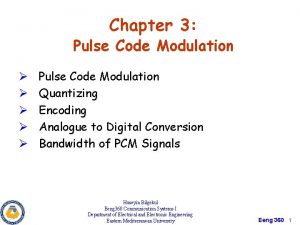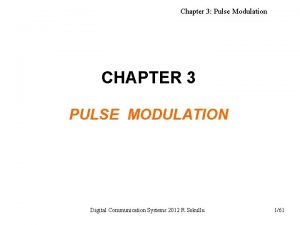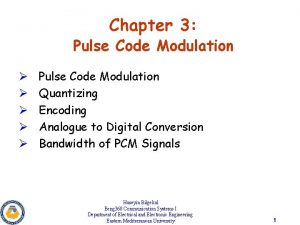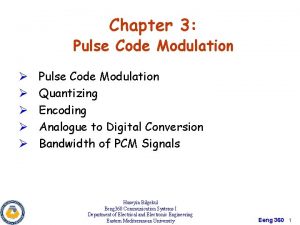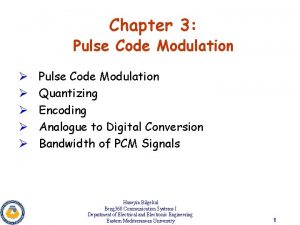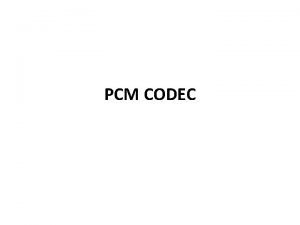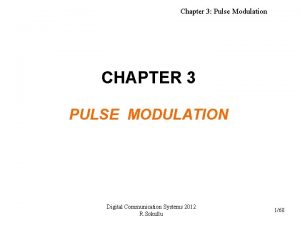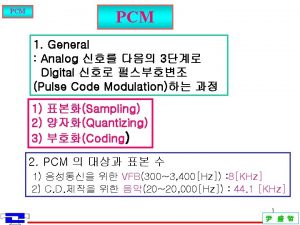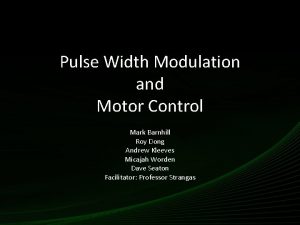Pulse Width Modulation Methods Institute for Electrical Drive



























- Slides: 27

Pulse Width Modulation Methods Institute for Electrical Drive Systems and Power Electronics Technical University of Munich Mohamed Abdelrahem Exercise: PWM methods 1

Introduction With fundamental frequency clocking (FFC), it is not possible to control the output voltage magnitude. Mohamed Abdelrahem Exercise: PWM methods 2

Introduction Changing the duty cycle controls the magnitude of the output voltage. Mohamed Abdelrahem Exercise: PWM methods 3

SPWM If the duty cycle is changes sinusoidally, a sinusoidal voltage will be generated in the output. Reference signal Carrier signal Sub-oscillation PWM (SPWM) Mohamed Abdelrahem Exercise: PWM methods 4

Modulation index It is possible to adjust the output voltage by adjusting the magnitude of the reference signal. generate Highest Voltage Modulation index The magnitude of the first harmonic of the output voltage by FFC method. The magnitude of the first harmonic of the output voltage by PWM method. Maximum modulation index Mohamed Abdelrahem Exercise: PWM methods 5

Other PWM Methods Third-harmonic PWM Reference signal= fundamental + third harmonic. The third harmonic will be filtered on the windings of the motor. The modulation index reaches 1. Mohamed Abdelrahem Exercise: PWM methods 6

Other PWM Methods Sixty-degree PWM Reference signal= fundamental + all non-even triple harmonics. The non-even triple harmonics will be filtered on the windings of the motor. The modulation index reaches 1. Mohamed Abdelrahem Exercise: PWM methods 7

Other PWM Methods Space Vector PWM Space vector PWM is implemented in a different manner as SPWM. It is derived based on the space vector concept. This method will be discussion in a later exercise. Mohamed Abdelrahem Exercise: PWM methods 8

Dead time upper switch Lower switch Mohamed Abdelrahem Exercise: PWM methods 9

Synchronized PWM Asynchronized PWM Synchronized PWM: PWM signal is identical in each cycle, which ensures stable output voltage. This important for high power applications. ASynchronized PWM: PWM signal is non-identical in each cycle, which causes different voltage forms in different cycles. However, if the frequency of the tringular is much higher than the reference, this effect can be neglected. Mohamed Abdelrahem Exercise: PWM methods 10

Symmetric PWM Asymmetric PWM methods are easier in implementation. Symmetric PWM methods evoke fewer harmonic interferences. Mohamed Abdelrahem Exercise: PWM methods 11

PWM Methods Exercise 1 Mohamed Abdelrahem Exercise: PWM methods 12

PWM Methods Exercise 1 Mohamed Abdelrahem Exercise: PWM methods 13

PWM Methods Exercise 1 Modulation index Mohamed Abdelrahem Exercise: PWM methods 14

PWM Methods Exercise 2 Mohamed Abdelrahem Exercise: PWM methods 15

PWM Methods Exercise 2 Mohamed Abdelrahem Exercise: PWM methods 16

PWM Methods Exercise 3 Mohamed Abdelrahem Exercise: PWM methods 17

Exercise 3 PWM Methods Mohamed Abdelrahem Exercise: PWM methods 18

Exercise 3 PWM Methods PWM signals Mohamed Abdelrahem Exercise: PWM methods 19

Exercise 3 PWM Methods Mohamed Abdelrahem Exercise: PWM methods 20

Exercise 3 PWM Methods 000 Mohamed Abdelrahem Exercise: PWM methods 21

Exercise 3 PWM Methods Voltages space vector Mohamed Abdelrahem Exercise: PWM methods 22

Exercise 3 PWM Methods Mohamed Abdelrahem Exercise: PWM methods 23

Exercise 3 PWM Methods Mohamed Abdelrahem Exercise: PWM methods 24

PWM Methods Exercise 3 Space vector trajectory of the currents Mohamed Abdelrahem Exercise: PWM methods 25

PWM Methods Exercise 3 Space vector trajectory of the currents at higher switching frequency Mohamed Abdelrahem Exercise: PWM methods 26

Question Thank you for your attention Mohamed Abdelrahem Exercise: PWM methods 27
 Advantage of pulse width modulation
Advantage of pulse width modulation What is duty cycle
What is duty cycle Multiple pulse width modulation
Multiple pulse width modulation What is pulse width modulation
What is pulse width modulation Amplitude modulation vs frequency modulation
Amplitude modulation vs frequency modulation Wave modulation
Wave modulation Advantages of angle modulation over amplitude modulation
Advantages of angle modulation over amplitude modulation Googlehttps://drive.google.com/drive/my-drive
Googlehttps://drive.google.com/drive/my-drive Googlehttps://drive.google.com/drive/my-drive
Googlehttps://drive.google.com/drive/my-drive Googlehttps://drive.google.com/drive/my-drive
Googlehttps://drive.google.com/drive/my-drive Pulse code modulation
Pulse code modulation Pulse code modulation and demodulation
Pulse code modulation and demodulation Manchester encoding scheme
Manchester encoding scheme Pcm represents
Pcm represents Pulse code modulation conclusion
Pulse code modulation conclusion Pulse code modulation conclusion
Pulse code modulation conclusion Hirst
Hirst Differentiate between belt drive and chain drive
Differentiate between belt drive and chain drive Https drive google com file d 0b8f5bmoit8kbmx
Https drive google com file d 0b8f5bmoit8kbmx Http drive google com
Http drive google com Difference between open belt drive and cross belt drive
Difference between open belt drive and cross belt drive Mpgu
Mpgu Rensselaer polytechnic institute electrical engineering
Rensselaer polytechnic institute electrical engineering Indirect wax pattern
Indirect wax pattern Formuö
Formuö Novell typiska drag
Novell typiska drag Nationell inriktning för artificiell intelligens
Nationell inriktning för artificiell intelligens Ekologiskt fotavtryck
Ekologiskt fotavtryck

